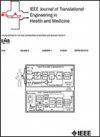基于GLRT和ST-CNN-Transformer网络多模态步态信号分析的帕金森病诊断和严重程度评定
IF 4.4
3区 医学
Q2 ENGINEERING, BIOMEDICAL
IEEE Journal of Translational Engineering in Health and Medicine-Jtehm
Pub Date : 2025-09-18
DOI:10.1109/JTEHM.2025.3611498
引用次数: 0
摘要
目的:帕金森病(PD)的诊断依赖于对运动和非运动症状的评估,步态异常是早期发现的关键标志。传统的临床评估往往依赖于视觉步态分析,这是一个容易产生偏差的主观过程。本研究介绍了一种利用步态特征的PD严重程度分类方法。方法:建立时空卷积神经网络-变压器(ST-CNN-Transformer) PD严重程度分类模型。与湖北省襄阳第一人民医院合作,收集了多模式步态数据,包括足部加速度、角速度和垂直地面反作用力(VGRF)。采用广义似然比检验(GLRT)检测零速度点,提取惯性测量单元数据的步态周期特征进行精确分割。ST-CNN-Transformer模型捕获了时空特征和周期性相关性。结果:对包含10名健康对照和30名PD患者的数据集进行评估,分类准确率为98.81%,超过了现有的基于步态的PD严重程度分类方法。结论:本研究引入了一种深度学习(DL)方法,通过整合来自多模态数据的ZVP和步态分割来实现PD严重程度的自动化分类。该模型显著提高了诊断准确率。意义:通过将深度学习与基于glrt的步态分割和多模态步态分析相结合,本研究提出了一个鲁棒性和可解释性的PD严重程度评估框架,有助于更准确、客观的临床决策。本文章由计算机程序翻译,如有差异,请以英文原文为准。
Diagnosis and Severity Rating of Parkinson’s Disease Based on Multimodal Gait Signal Analysis With GLRT and ST-CNN-Transformer Networks
Objective: Parkinson’s disease (PD) diagnosis relies on the evaluation of motor and non-motor symptoms, with gait abnormalities serving as a key marker for early detection. Traditional clinical assessment often relies on visual gait analysis, which is a subjective process prone to bias. This study introduces a PD severity classification method that leverages gait features. Methods: A Spatial-temporal Convolutional neural network-Transformer (ST-CNN-Transformer) model for PD severity classification was established. Multimodal gait data, including foot acceleration, angular velocity, and Vertical Ground Reaction Force (VGRF), were collected in collaboration with Xiangyang First People’s Hospital, Hubei Province. Zero-velocity points (ZVPs) were detected using the Generalized Likelihood Ratio Test (GLRT), and gait cycle features were extracted from inertial measurement unit data for precise segmentation. The ST-CNN-Transformer model captures spatial-temporal features and periodic correlations. Results: Evaluation on a dataset comprising 10 healthy controls and 30 PD patients yielded a classification accuracy of 98.81%, surpassing existing gait-based methods for PD severity classification. Conclusion: This study introduces a deep learning (DL) approach to automating PD severity classification by integrating ZVP and gait segmentation derived from multimodal data. The proposed model significantly enhances diagnostic accuracy. Significance: By combining DL with GLRT-based gait segmentation and multimodal gait analysis, this study proposes a robust and interpretable PD severity assessment framework that contributes to more accurate and objective clinical decision-making.
求助全文
通过发布文献求助,成功后即可免费获取论文全文。
去求助
来源期刊

IEEE Journal of Translational Engineering in Health and Medicine-Jtehm
Engineering-Biomedical Engineering
CiteScore
7.40
自引率
2.90%
发文量
65
审稿时长
27 weeks
期刊介绍:
The IEEE Journal of Translational Engineering in Health and Medicine is an open access product that bridges the engineering and clinical worlds, focusing on detailed descriptions of advanced technical solutions to a clinical need along with clinical results and healthcare relevance. The journal provides a platform for state-of-the-art technology directions in the interdisciplinary field of biomedical engineering, embracing engineering, life sciences and medicine. A unique aspect of the journal is its ability to foster a collaboration between physicians and engineers for presenting broad and compelling real world technological and engineering solutions that can be implemented in the interest of improving quality of patient care and treatment outcomes, thereby reducing costs and improving efficiency. The journal provides an active forum for clinical research and relevant state-of the-art technology for members of all the IEEE societies that have an interest in biomedical engineering as well as reaching out directly to physicians and the medical community through the American Medical Association (AMA) and other clinical societies. The scope of the journal includes, but is not limited, to topics on: Medical devices, healthcare delivery systems, global healthcare initiatives, and ICT based services; Technological relevance to healthcare cost reduction; Technology affecting healthcare management, decision-making, and policy; Advanced technical work that is applied to solving specific clinical needs.
 求助内容:
求助内容: 应助结果提醒方式:
应助结果提醒方式:


